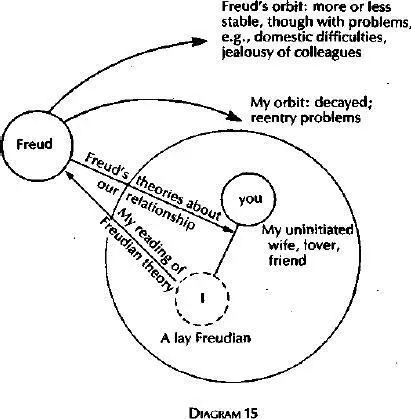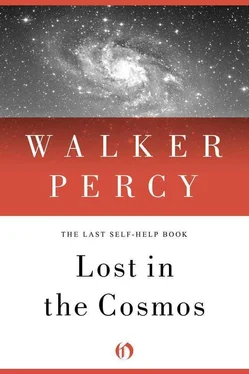(ii) Decayed Orbits of Transcendence. The layman can in some cases participate in the transcendent community of science, but often at a price.
Consider a familiar example, the lay Freudian, that is, the avid reader and disciple of Freud who does, to a degree, share in the excitement of Freud’s insights but whose excitement all too often derives not from a shared discovery but from the sense of election to an elite from which vantage point one can play a one-upmanship game with ordinary folk: “What you say is not really what you mean. What you really mean, whether you know it or not, is—”
Their impoverishment is to be located in both an inflation of theory and a devaluation of the world theorized about. They out-Freud Freud without the scruples of Freud.
Yet they, the lay scientists, those who perceive themselves in the community of scientists and at some remove from the ordinary world, may be better off than those who live immanent lives, beneficiaries of science and technology, but with only a glimmering of the scientists, the glimmering that there are scientists and that “they” know about every sector of the world, including one’s very self. “They” not only know about the Cosmos, they know about me, my aches and pains, my brain functions, even my neuroses. A remarkable feature of the secondhand knowledge of scientific transcendence is the attribution of omniscience to “them.” “They” know.

The Decayed Orbit of the Lay Freudian or, How it is one thing to be Freud and to spend a life inducing a remarkable theory from the endlessly complex manifold of human phenomena and, How it is something else to read some Freud, master a few principles, return to the ordinary world and human relationships with the sense that you alone are privy to the hidden mechanisms of these relationships. Such reentries can be disastrous for both parties, Freudian and non-Freudian.
They are expected to know. Example: a recent Donahue Show in which paraplegics discussed their troubles. The message: rage at doctors. “They” could cure us if they wanted to, took the time, did their research. The powers attributed to them, the scientists — powers which they, the scientists, never claimed — are as magical as those of the old gods.
The layman, dazzled by the extraordinary accomplishments of science and technology, nevertheless gives away too much to science. Where the genuine scientist is generally amazed at the meagerness of knowledge in his own field, the layman is apt to assign omniscience as what he takes to be a property of scientific transcendence.
(iii) Transcendence by Art. If the scientist is the prince of the post-religious age, lord and sovereign of the Cosmos itself through his transcendence of it, the artist is the suffering servant of the age, who, through his own transcendence and his naming of the predicaments of the self, becomes rescuer and savior not merely to his fellow artists but to his fellow sufferers. Like the scientists, he transcends in his use of signs. Unlike the scientists, he speaks not merely to a small community of fellow artists but to the world of men who understand him.
It is no accident that, for the past hundred years or so, the artist (poet, novelist, painter, dramatist) has registered a dissent from the modern proposition that, with the advance of science and technology, man’s lot will improve in direct proportion. The alienation of the artist puzzles many, both the scientists and technologists who are happy and busy and their lay beneficiaries who are happy in the immanence of consumption. Most Danes and Japanese don’t appear to be alienated — though there are those who say that their obliviousness of their own immanence is the worst alienation of all. To most of the happy von Frisches and Rutherfords and to the contented denizens of Silicon Valley, the dark views of modern life held by most serious novelists since Tolstoy, most poets since Tennyson, most painters since Millet, most dramatists since Schiller, have seemed neurotic indulgences. It is possible, however, that the artist is both thin-skinned and prophetic and, like the canary lowered into the mine shaft to test the air, has caught a whiff of something lethal. Indeed, as this dreadful century wears on, even the most immanent Dane and the most proficient IBM computer-engineer is beginning to sense that all is not well, that the self can be as desperately stranded in the transcendence of theory as in the immanence of consumption.
The artist, caught in the predicament of the self, is at once more vulnerable to the predicament of self than the nonartist and at the same time privileged to escape it by the transcendence of his art. He serves others who share his predicament by naming it.
The difference between Einstein and Kafka, both sons of middle-class middle-European families, both of whom found life in the ordinary world intolerably dreary:
Einstein escaped the world by science, that is, by transcending not only the world but the Cosmos itself.
Kafka also escaped his predicament — occasionally — not by science but by art, that is, by seeing and naming what had heretofore been unspeakable, the predicament of the self in the modern world.
The salvation of art derives in the best of modern times from a celebration of the triumph of the autonomous self — as in Beethoven’s Ninth Symphony — and in the worst of times from naming the unspeakable: the strange and feckless movements of the self trying to escape itself.
Exhilaration comes from naming the unnameable and hearing it named.
If Kafka’s Metamorphosis is presently a more accurate account of the self than Beethoven’s Ninth Symphony, it is the more exhilarating for being so.
The naming of the predicament of the self by art is its reversal. Hence the salvific effect of art. Through art, the predicament of self becomes not only speakable but laughable. Helen Keller and any two-year-old and Kafka’s friends laughed when the unnameable was named. Kafka and his friends laughed when he read his stories to them.
The community of art is not the elect community of science but the community of the artist and all who share his predicament and who can understand his signs.
The impoverishment? It comes from the transience of the salvation of art, both for the maker of the sign (the artist) and for the receiver of the sign.
The self in its predicament is exhilarated in both the making and the receiving of a sign — for a while.
After a while, both the artist and the self which receives the sign are back in the same fix or worse — because both have had a taste of transcendence and community.
If poets often commit suicide, it is not because their poems are bad but because they are good. Whoever heard of a bad poet committing suicide? The reader is only a little better off. The exhilaration of a good poem lasts twenty minutes, an hour at most.
Unlike the scientist, the artist has reentry problems that are frequent and catastrophic.
In fact, a catalogue of the spectacular reentries and flameouts of the artist is nothing other than a pathology of the self in the twentieth century, much as the fits and frenzies of Saint Vitus’s Dance were signs of the ills of an earlier age.
What account, then, can a semiotic give of the paradoxical impoverishments and enrichments of the self in the present age?
Why do people often feel bad in good environments and good in bad environments? Why did Mother Teresa think that affluent Westerners often seemed poorer than the Calcutta poor, the poorest of the poor?
The paradox comes to pass because the impoverishments and enrichments of a self in a world are not necessarily the same as the impoverishments and enrichments of an organism in an environment.
Читать дальше













